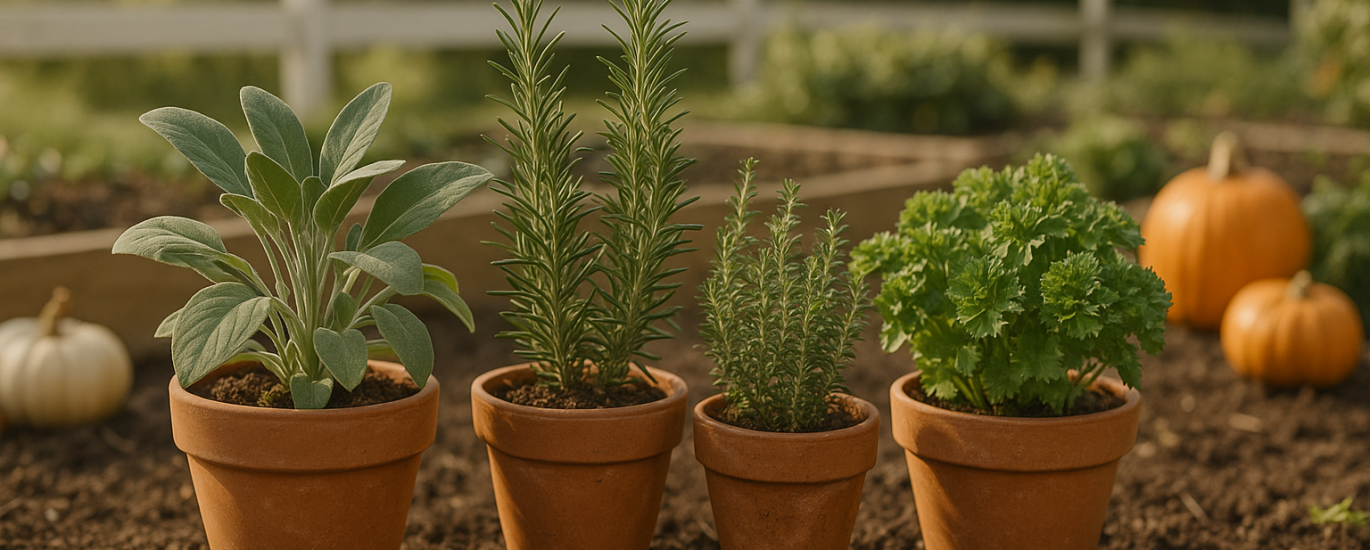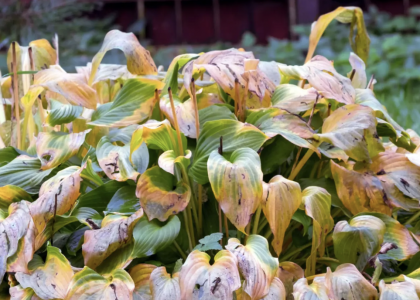A beginner-friendly guide to growing seasonal herbs that elevate your home, cooking, and holiday gatherings.
Thanksgiving isn’t just about the feast—it’s also about warmth, belonging, gratitude, and the meaningful details that make the season feel special. A Thanksgiving Herb Garden brings all of that into your home: fragrance, beauty, healing symbolism, and ingredients you can actually use in your holiday dishes.
Whether you grow herbs on a small balcony, a bright windowsill, or a raised bed outdoors, this guide will help you create a seasonal herb garden filled with flavor, tradition, and festive charm.
Why Grow a Thanksgiving Herb Garden?
A Thanksgiving Herb Garden brings together flavor, meaning, and seasonal beauty—making it one of the most practical and heartfelt ways to elevate your holiday home.
✓ Practical
Fresh herbs instantly upgrade your Thanksgiving menu.
Use them in stuffing, roasted vegetables, turkey rubs, compound butters, breads, and even festive cocktails.
✓ Seasonal
Many cool-weather herbs reach their peak in fall.
Sage, rosemary, thyme, and parsley all thrive as temperatures drop, making them ideal for this time of year.
✓ Symbolic
Recent Google Trends searches show rising interest in:
“herb symbolism,” “gratitude garden,” “seasonal decorating ideas,” and “mindfulness moments.”
Each herb carries its own meaning—gratitude, renewal, courage, peace—perfect for a season centered around appreciation and family.
✓ Decorative
Pinterest’s top Q4 searches include:
“herb table décor,” “fall minimalist table setting,” and “pumpkin + herbs centerpiece.”
Fresh-cut herbs instantly bring softness, fragrance, and a natural seasonal touch to your Thanksgiving table, making them both beautiful and useful.
Top Thanksgiving Herbs to Grow (and why they matter)
1. Sage — Cleansing & Renewal
The iconic herb in Thanksgiving stuffing.
- Flavor: earthy, warm, slightly peppery
- Best Use: stuffing, compound butter, roasted vegetables
- Symbolism: renewal, clarity, peace
Grow Tip: Sage likes full sun and well-drained soil—perfect for indoor pots in fall.
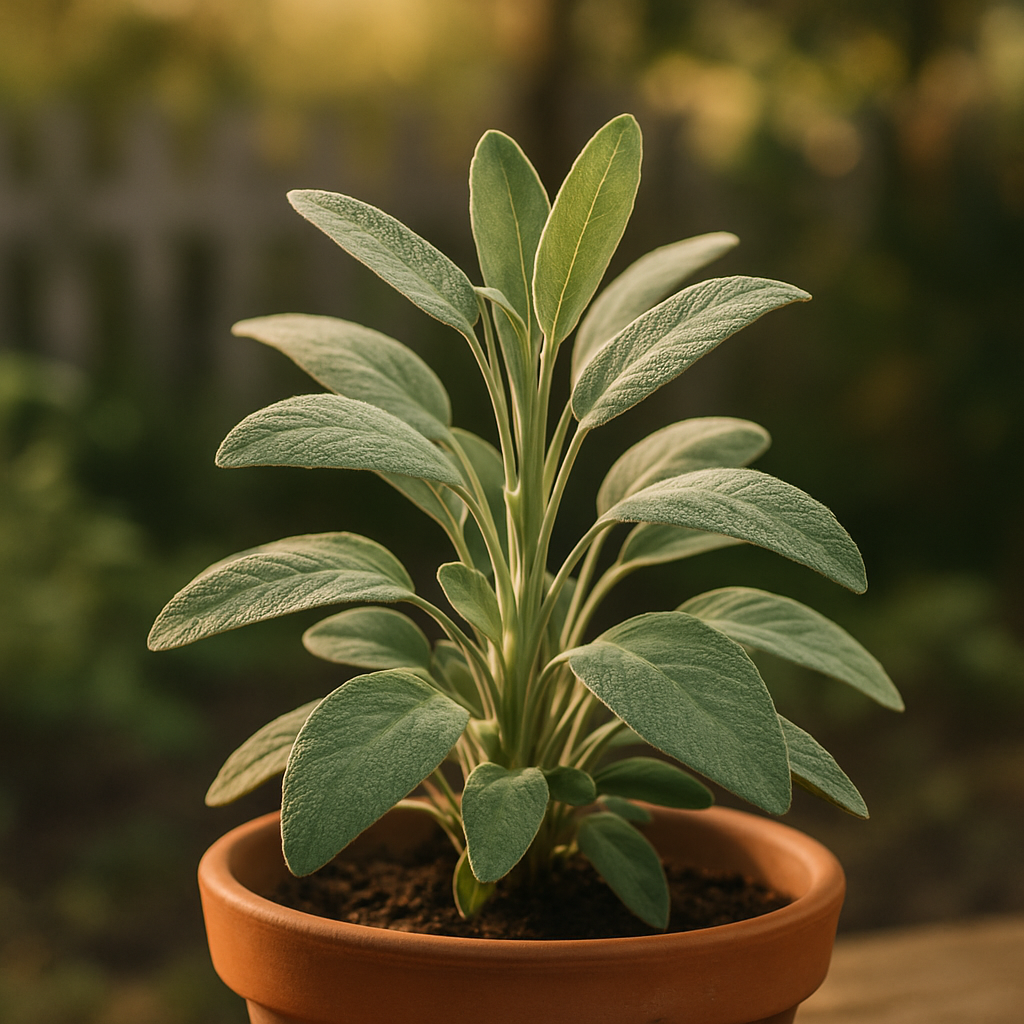
2. Rosemary — Memory & Gratitude
A favorite in roasted dishes and fall simmer pots.
- Flavor: piney, bright, aromatic
- Best Use: turkey rubs, potatoes, breads
- Symbolism: gratitude, remembrance
Grow Tip: Avoid overwatering; rosemary prefers to stay on the dry side.

3. Thyme — Comfort & Abundance
One of the most versatile culinary herbs of the season.
- Flavor: subtle lemon-earthiness
- Best Use: gravy, roasted chicken, root vegetables, soups
- Symbolism: courage, steady growth
Grow Tip: Thrives in cool weather and pairs well with fall vegetables.

4. Parsley — Freshness & Blessing
A bright green herb that balances heavier Thanksgiving flavors.
- Flavor: clean, herbaceous
- Best Use: garnishes, herb butters, salads
- Symbolism: blessing, protection
Grow Tip: Keep soil consistently moist for lush foliage.
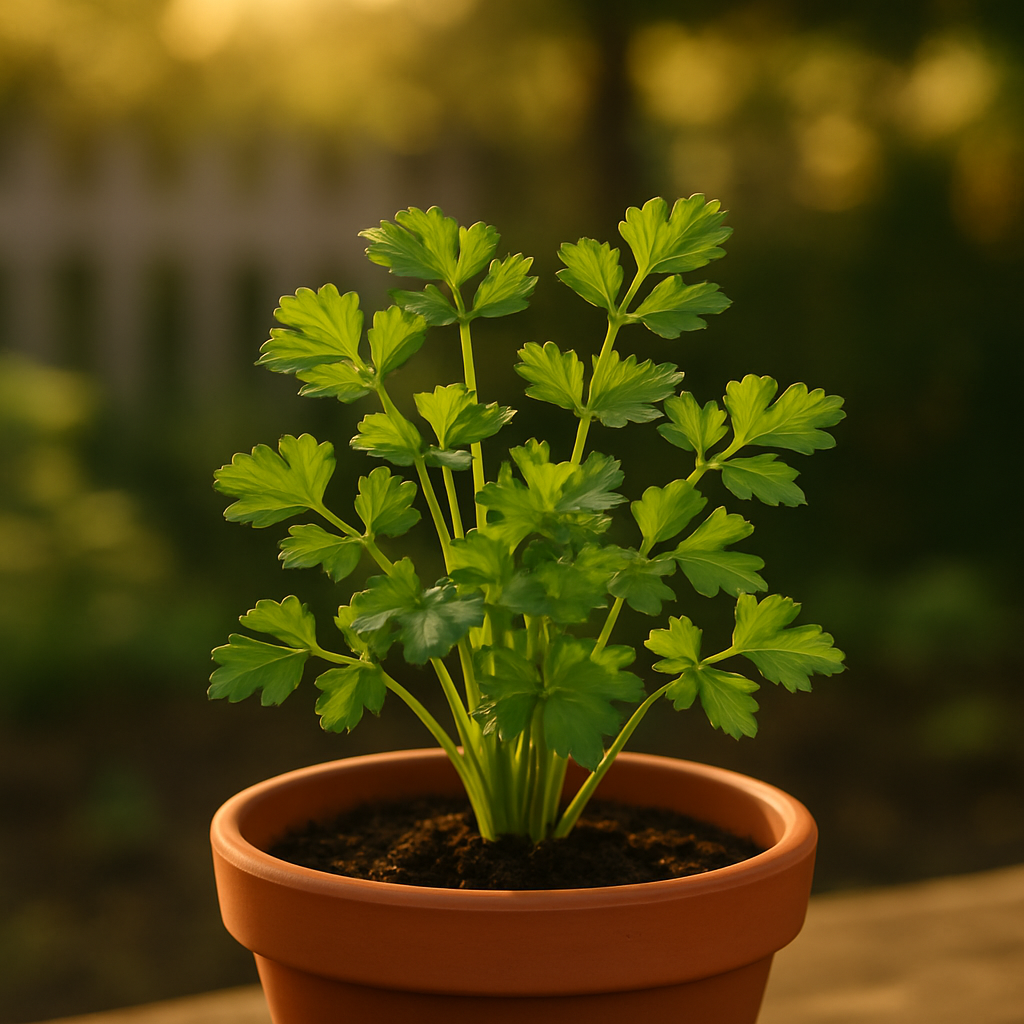
5. Chives — Celebration & Family Warmth
Light onion flavor without overpowering dishes.
- Flavor: mild onion
- Best Use: mashed potatoes, compound butter, dips
- Symbolism: connection, warmth
Grow Tip: Cut often to encourage new growth.
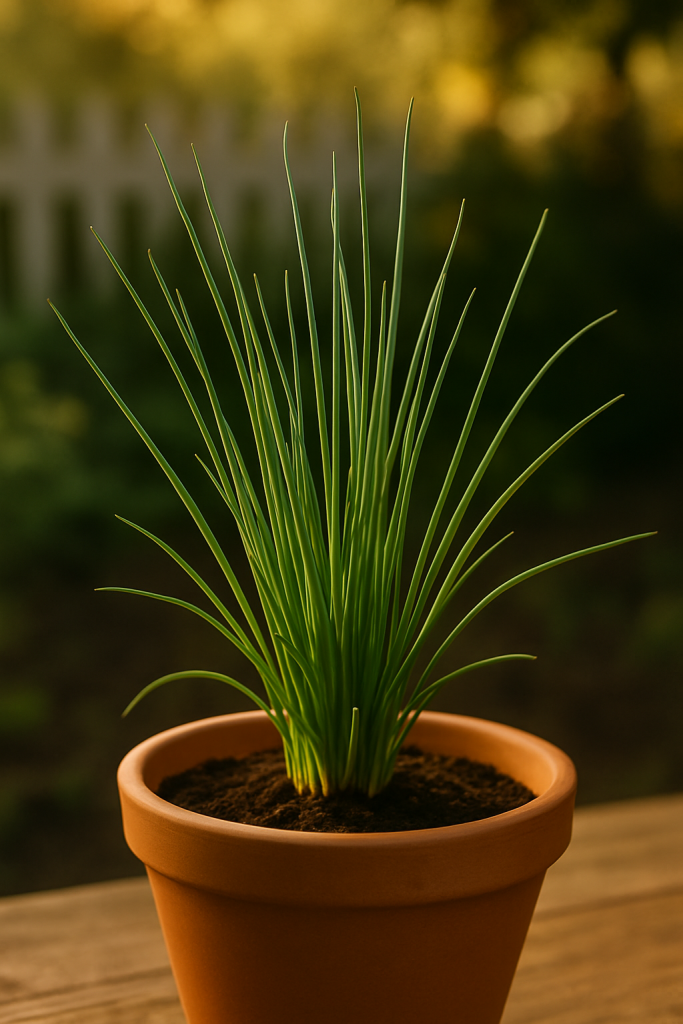
Creating a Thanksgiving Herb Garden — Step-by-Step
1. Choose Your Growing Spot
A rising seasonal search trend—“small-space herb gardening”—shows that you don’t need a large yard to grow a beautiful Thanksgiving herb collection.
Ideal locations include:
- A sunny kitchen windowsill
- A balcony planter box
- A porch railing herb box
- Indoor shelves with grow lights
Light requirement: Aim for 4–6 hours of sunlight per day.
2. Pick the Best Pots for Fall
Now is trending with searches like “beige pottery” and “neutral ceramic planters,” which perfectly match the warm, earthy tones of the Thanksgiving season.
Great pot choices:
- Terracotta pots
- Cream or ivory ceramic planters
- Rustic baskets (with liners)
These blend beautifully with fall décor and make your herb garden feel naturally seasonal.
3. Use a Fall-Friendly Soil Mix
For strong, aromatic herbs, plant them in a light, well-draining mix:
- High-quality potting soil
- Perlite for drainage
- Compost for added nutrients
Herbs grow quickly and stay flavorful when the soil is rich yet airy.
4. Arrange Herbs by Flavor Group (Chef-Recommended)
Organizing herbs by flavor makes Thanksgiving cooking easier and more intuitive.
Savory Cluster
- Sage
- Thyme
- Rosemary
Fresh Cluster
- Parsley
- Chives
- Mint (optional)
Place each cluster in its own pot or grouped container for easy harvesting.
5. Add Seasonal Accents for Décor
A big trend this year is “pumpkin + herbs tablescape.”
It’s simple, cozy, and incredibly photogenic.
Add touches such as:
- Mini white pumpkins
- Dried orange slices
- Cinnamon sticks
- Soft linen napkins
- Maple leaves
These natural elements elevate both your garden and your Thanksgiving table décor.
How to Use Your Herbs for Thanksgiving Cooking
Fresh herbs are one of the easiest ways to elevate the flavors and aromas of your Thanksgiving meal. Here’s how to make the most of the herbs you grow.
Stuffing Herbs (The Essential Trio)
- Sage
- Rosemary
- Thyme
These three herbs create the classic savory, comforting fragrance that defines traditional Thanksgiving stuffing. Use them fresh for deeper aroma and more vibrant flavor.
Turkey Rub Herbs
- Rosemary
- Thyme
- Parsley
Combine these herbs with olive oil, minced garlic, salt, and pepper to create a fragrant, flavorful turkey rub. The mix coats the skin beautifully and keeps the meat moist and aromatic during roasting.
Potatoes & Root Vegetables
- Chives
- Thyme
Chives add a fresh, mild onion flavor that brightens mashed potatoes, baked potatoes, and creamy dips. Thyme pairs perfectly with roasted root vegetables like carrots, parsnips, and sweet potatoes, bringing earthy depth to each dish.
Warm Drinks & Simmer Pots
- Rosemary
- Orange peel
- Cinnamon sticks
This combination is perfect for cozy fall drinks or stovetop simmer pots. As Google Trends shows increasing searches for “holiday simmer pot recipes,” these fragrant blends are becoming a seasonal favorite. They fill your home with notes of citrus, spice, and herbaceous warmth—ideal for welcoming guests.
Thanksgiving Herb Décor Ideas
Pinterest searches for “neutral fall centerpiece,” “herb napkin toppers,” and “simple tablescape ideas” continue to rise, making herb-based decorations one of the most popular and stylish trends for the season. Here are three easy, high-impact décor ideas that bring warmth, fragrance, and elegance to your Thanksgiving table.
1. Herb Napkin Toppers
Tie a small bundle of rosemary and sage with natural jute twine, then place it on top of each napkin.
The combination adds a soft, earthy fragrance and instantly elevates a simple table setting with a seasonal touch.
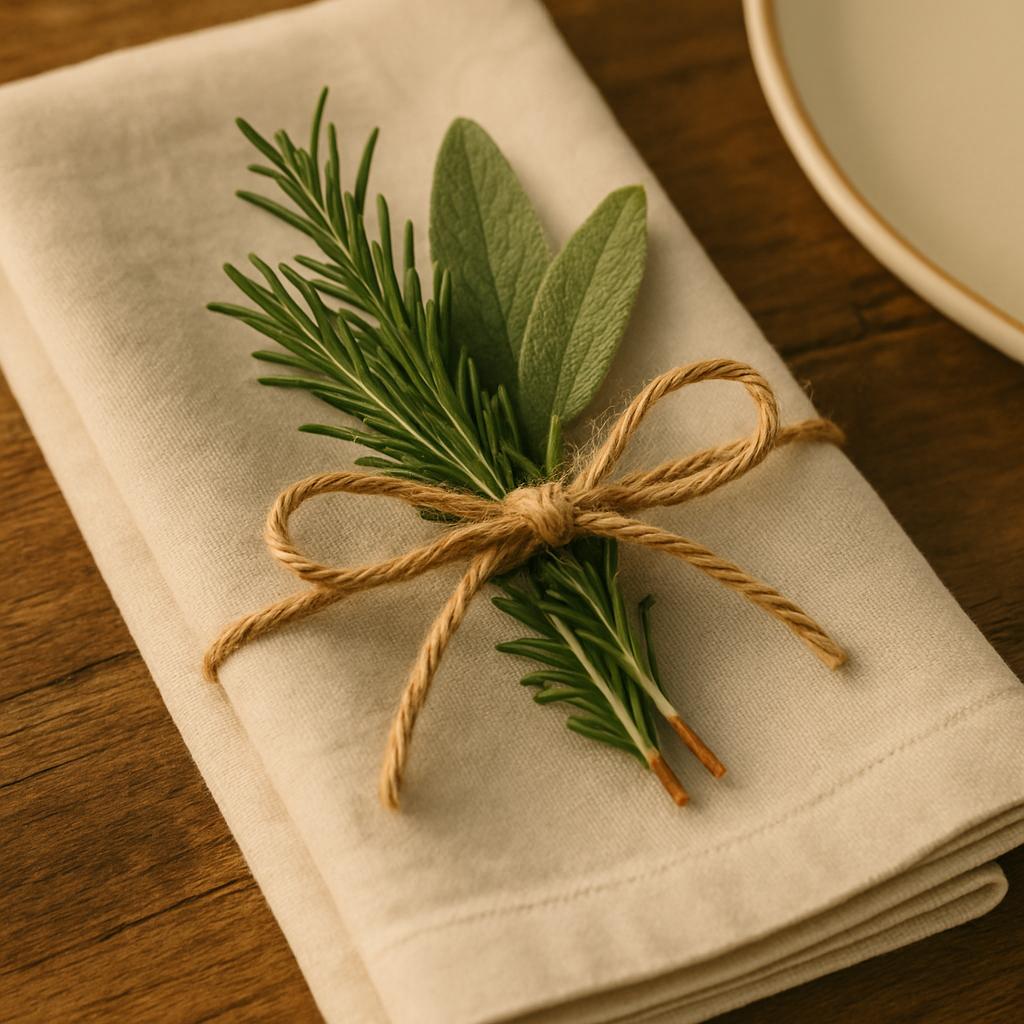
2. Mini Pumpkin Herb Vase
Hollow out a mini pumpkin and tuck in a fresh chrysanthemum or a sprig of rosemary.
This charming, rustic accent works beautifully as a centerpiece or placed along a simple fall tablescape.

3. Gratitude Herb Cards
Create small place cards using a handwritten name tag and a tiny herb bundle.
Guests can take them home as a thoughtful keepsake—perfect for adding meaning and gratitude to your gathering.

Herbs & Symbolism: Add Meaning to Your Meal
With growing interest in “symbolic plants” and intentional living, many home gardeners and holiday hosts are choosing herbs not only for their flavor but also for the deeper meaning they bring to the table. Incorporating symbolic herbs into your Thanksgiving décor adds a thoughtful touch that guests notice and appreciate.
| Herb | Meaning | Perfect For |
|---|---|---|
| Sage | Renewal, peace | Opening the gathering with calm and intention |
| Rosemary | Gratitude, memory | Honoring family traditions and loved ones |
| Thyme | Courage, growth | Encouraging fresh starts and hopeful conversations |
| Chrysanthemum | Appreciation | A warm, elegant centerpiece for the holiday table |
These symbolic touches turn your Thanksgiving meal into more than a feast—they transform it into a moment of reflection, connection, and shared gratitude.
Beginner-Friendly Care Tips (Fall Edition)
Keeping your Thanksgiving herb garden healthy through fall is simple with a few easy habits. These beginner-friendly tips ensure your herbs stay flavorful, full, and thriving throughout the season:
- Water only when the top inch of soil feels dry.
Overwatering is one of the most common mistakes—most herbs prefer slightly dry conditions.
- Rotate your pots weekly for even growth.
This helps each plant receive uniform light and prevents lopsided growth.
- Trim your herbs regularly to encourage fuller, bushier plants.
Frequent harvesting stimulates new, healthy growth.
- Bring tender herbs indoors when temperatures drop below 5°C (41°F).
Sage, rosemary, and thyme can tolerate cooler nights, but parsley, chives, and mint may need extra protection.
Final Thoughts
A Thanksgiving Herb Garden brings more than fragrance and flavor—it cultivates grateful presence, connects your home with the season, and gives you meaningful rituals to share with your loved ones.
Small space or large outdoor porch—it doesn’t matter.
Every pot becomes a place for gratitude to grow.

